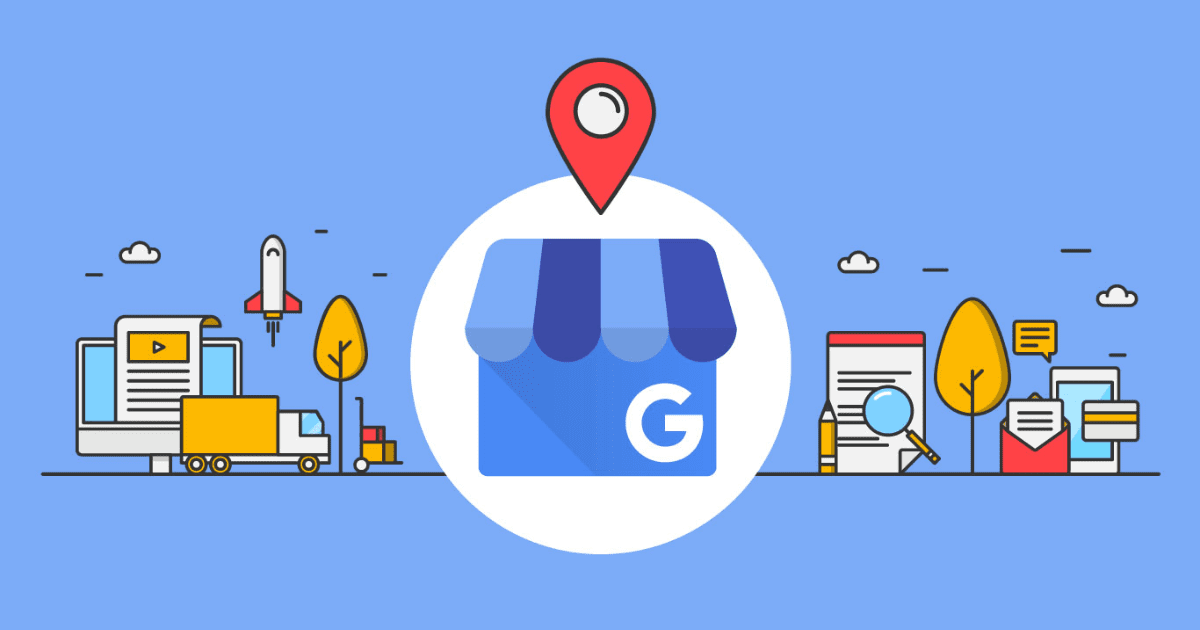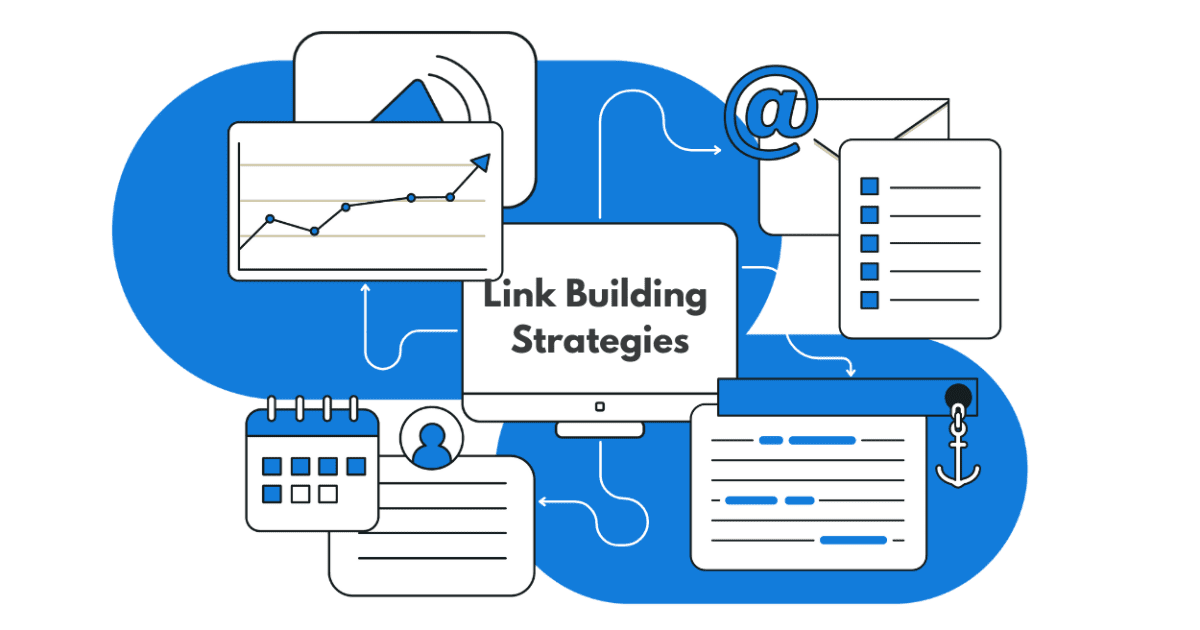Even in 2024, Local SEO continues to be a cornerstone for businesses aiming to dominate their regional market and attract a loyal customer base. With increasingly sophisticated search engine algorithms, your Local SEO strategies must evolve to stay ahead of the curve.
This guide will outline vital steps and best practices to enhance online visibility and connect with customers nearby. Businesses can optimize their digital footprint by focusing on local search engine optimization, ensuring they appear in local searches and stand out.
We’ve compiled this complete local SEO checklist to help you stay on top of your local SEO game in 2024. By following these steps, you can improve your rankings and attract more customers to your business.

Google My Business Optimization
Google My Business (GMB) is a free tool by Google that helps businesses manage their online presence across various Google platforms, including Google Search and Google Maps. It’s an essential part of any local SEO strategy; optimizing it can significantly improve your local search visibility.
Completing and Optimizing Your Business Profile
Your GMB profile forms the foundation of your local SEO efforts. It’s essential to fill it out completely and accurately. The profile should include your business name, address, and phone number (NAP), along with other relevant details like your operating hours, business categories, and a brief description of your services.
Using relevant keywords in your business description can help improve your visibility in local searches. For instance, if you run a bakery in Austin, include keywords like “Austin bakery” or “baked goods in Austin” in your description. However, avoid keyword stuffing as it can harm your SEO efforts.
Adding Photos, Videos, Posts, Products/Services
Visual content plays a significant role in engaging potential customers. According to a study by BrightLocal, businesses with more than 100 images on their GMB listing get 520% more calls than the average business. Hence, adding high-quality photos and videos of your products, services, or premises can enhance your profile’s appeal.
Regularly updating your GMB listing with posts about new products, special offers, or upcoming events can keep your audience engaged and informed. Use local keywords in your posts to increase their visibility in local search results.
Monitoring Insights and Metrics
Google provides valuable insights and metrics about your GMB listing, such as how customers found it, their actions, and their location. Regularly monitoring these metrics can help you better understand your local customer base and fine-tune your local SEO strategy accordingly.
Thus, by ensuring your business profile is complete and optimized, regularly updating it with engaging content, and monitoring your performance, you can significantly improve your visibility in local search results and attract more local customers to your business.

Local Keyword Research and Implementation
Local keyword research is a fundamental aspect of any local SEO strategy. Businesses can significantly boost their visibility in local search results by identifying and using the right local keywords.
Targeting Keywords with City, Neighborhood, Zip
When internet users search for local businesses or services, they often include geographical identifiers like city names, neighborhoods, or zip codes in their search queries. For example, a user looking for a bakery might search for “bakery in Austin” or “bakery near 78701”.
To take advantage of this, businesses should target location-specific keywords in their content. This can be achieved by including these keywords naturally in web pages, blog posts, meta descriptions, and title tags. Remember, relevance is key. Only use geographical identifiers that relate to your business location and service areas.
Optimizing Pages for Local Intent
Optimizing your web pages for local intent involves more than just sprinkling relevant keywords throughout your content. It’s about understanding and meeting the needs of local searchers.
Ensure that your business name, address, and phone number (NAP) are prominently displayed on your website and consistent across all online platforms. Use schema markup to provide Google and other search engines with detailed information about your local business, products, or services.
Furthermore, consider creating location-specific landing pages if your business operates in multiple locations. Each page should be tailored to the specific area, including local news, events, or customer testimonials.
Tracking Keyword Rankings in SERPs
Monitoring your keyword rankings in Search Engine Results Pages (SERPs) is crucial for gauging the effectiveness of your local SEO efforts. Tools like Google Search Console, SEMRush, or Moz can provide valuable insights into your keywords’ performance and identify improvement areas.
According to a study, 92% of consumers choose businesses on the first page of local search results. Therefore, improving your keyword rankings can significantly increase your chances of attracting more local customers.

Online Reviews Management
In local SEO, online reviews are pivotal in shaping your business’s reputation and influencing potential customers’ decisions. Therefore, effectively managing these online reviews can significantly enhance your local SEO strategy.
Prompting Customers to Leave Reviews
Encouraging your customers to leave online reviews is an essential first step in managing your online reputation. 70% of consumers are willing to write a review when asked. Therefore, don’t hesitate to send a friendly email or message asking for their feedback.
Make it easy for customers to leave reviews by providing direct links to your review profiles on Google, Yelp, Facebook, and other relevant platforms. You can also place visible calls-to-action (CTAs) on your website and social media pages.
You can also implement strategies like sending post-purchase emails asking for reviews or incorporating review prompts on your website and social media sites.
However, ensure this process is as straightforward as possible. Simplify the review submission process by providing clear instructions and direct links to your review pages on platforms like Google My Business or other reputable websites.
Responding Professionally to All Reviews
Responding to online reviews, both positive and negative, is an integral part of reviews management. A professional and timely response to a negative review can turn a dissatisfied customer into a loyal one, while acknowledging positive reviews can enhance your relationship with satisfied customers.
Ensure your responses are personalized, addressing the reviewer’s concerns or appreciating their positive feedback. This improves your relationship with your customers and signals to search engines that you actively manage your online presence, which can positively impact your local SEO ranking.
Highlighting Positive Feedback
Highlighting positive feedback can further boost your business’s reputation. Share positive reviews on your website, blog posts, and social media platforms. This acts as a form of social proof, demonstrating to potential customers that others have had a positive experience with your business.
Remember to seek permission from reviewers before sharing their feedback. This respectful approach can enhance your customer relationship and foster trust in your business.
Managing online reviews is thus critical to a robust local SEO strategy. By prompting customers to leave reviews, professionally responding to all feedback, and highlighting positive reviews, you can improve your online reputation, boost your local search rankings, and attract more customers to your business.

Local Link Building
Local link building is a powerful technique that can significantly improve your local SEO ranking factors. It involves acquiring backlinks from other local websites, which enhances your website’s authority and visibility in local search results. Here are three practical strategies to build local links:
- Obtaining Links from Directories and Niche Sites: Online directories and niche sites are valuable resources for local link building. These platforms often have high domain authority and cater to a specific target audience. Begin by listing your business on reputable local directories, ensuring your business name, address, and phone number are consistent across all listings. Additionally, identify niche sites related to your industry and explore opportunities for guest blogging or sponsored posts. When executed properly, this strategy can bring quality backlinks and drive relevant traffic to your web pages.
- Partnerships with Complementary Local Businesses: Partnering with complementary local businesses can offer mutual benefits regarding local link building. For instance, a bakery might partner with a coffee shop, each linking to the other’s website in blog posts or promotional material. This strategy boosts your local SEO, fosters a sense of community among local businesses, and potentially increases customer referrals.
- Pitching Relevant Local Publications: Local news sites, magazines, and online publications always seek interesting stories or expert insights. Pitching these publications with unique story ideas or offering to contribute expert content can result in valuable local backlinks. Remember, the key to successful pitching is relevance. Your pitch should align with the publication’s target audience and editorial guidelines.
Incorporating these strategies into your local SEO campaign can help you acquire quality local backlinks, enhance your search engine visibility, and strengthen your position in local search results.
Encouraging Customer Loyalty and Repeat Business
Focusing on customer loyalty and repeat business can yield significant dividends in the context of a local SEO strategy. By fostering strong relationships with your local customers, you increase your chances of securing repeat business and improve your local search ranking factors.
Retention Programs and Incentives
Customer retention programs and incentives are powerful tools to encourage repeat business. These can range from loyalty programs that offer rewards for frequent purchases, to exclusive discounts for returning customers. According to a study by Bain & Company, increasing customer retention rates by 5% can increase profits by 25% to 95%.
Implementing these programs requires understanding your local customers’ needs and preferences. Use data from your business analytics to develop appealing incentives that will encourage your customers to keep coming back.
Personalized Email, SMS, Messaging
Personalization is a key factor in building strong customer relationships. Tailored email campaigns, SMS, or messaging can make your local customers feel valued and appreciated, thus increasing their likelihood of repeat business.
Utilize customer data to personalize your communication efforts. This can include sending personalized offers based on past purchases, birthday greetings, or messages highlighting new products or services that align with their interests. Such strategies demonstrate that you value their patronage, fostering loyalty and encouraging repeat business.
Loyalty and Refer-a-Friend Promotions
Loyalty and refer-a-friend promotions effectively retain existing customers and attract new ones. For instance, offering a discount or free product to customers who refer a friend can incentivize your current customers to spread the word about your business.
Such promotions reward your loyal customers and leverage their networks to reach potential customers. This dual approach enhances your local SEO strategy by expanding your customer base and boosting your reputation among local consumers.

Mobile Optimization
Mobile optimization should be an essential component of your local SEO checklist for 2024. With the evolution of search engines and the growing reliance on mobile devices for local searches, your local business website needs to meet the expectations of mobile users to achieve a strong local SEO strategy.
Fast Loading Pages
Speed is a crucial factor in mobile optimization. Page speed is an important ranking factor for search engines like Google. As per Google’s research, 53% of mobile users abandon sites that take longer than three seconds to load. To excel in local search results, it’s vital to ensure your web pages load quickly on mobile devices.
To achieve this, consider optimizing images, minimizing heavy scripts, and leveraging browser caching. Tools like Google’s PageSpeed Insights can help identify areas of improvement, ultimately enhancing your local SEO ranking factors.
Streamlined Design and Navigation
The design and navigation of your local business site play a pivotal role in user experience. A streamlined design responsive to different screen sizes ensures functionality and accessibility across various mobile devices. Clear and intuitive navigation guides local searchers through your site, making it easier for them to find relevant information or complete desired actions.
This improves the user experience and increases the likelihood of conversions, contributing to your local SEO campaign. Remember, a well-designed, easy-to-navigate site will likely rank higher on search engines and attract potential customers.
Easy Access to Calls and Directions
Most local businesses aim to drive real-world visits or inquiries from their online presence. Ensuring easy access to calls and directions is a key step towards achieving this goal. Your business phone number should be click-to-call, and your Google Business Profile should include a map or directions feature.
This simplifies the process for potential customers, making them more likely to choose your business over others. Plus, it improves your visibility on Google Maps, a crucial aspect of local SEO.
In sum, mobile optimization should be a priority in your local SEO checklist. By focusing on fast-loading pages, streamlined design and navigation, and easy access to calls and directions, you can improve your local SEO ranking factors, enhancing your visibility in local search results.

Schema Markup for Local Businesses
Schema markup, a powerful yet often overlooked component of a strong local SEO strategy, can significantly enhance your local business’s visibility in search results. By providing search engines with additional information about your business, schema markup can help improve your local search ranking and attract more local customers.
Name, Address, Opening Hours
The first step in implementing schema markup for your local business is to provide key details like your business name, address, and opening hours. This helps search engines understand your business and its operations better, making it easier for them to present your business accurately in local search results.
Ensure these details are consistent across all your web pages and online local listings. Consistency in these details is an important ranking factor for local SEO, as it gives search engines more confidence in the accuracy of the information they provide to local searchers.
Review Snippets and FAQ Markup
Review snippets and FAQ markup are two types of schema markup that can enhance your local business’s visibility in search results. Review snippets present a summary of customer reviews on your site, while FAQ markup allows you to highlight common questions and their answers.
These markups improve your search engine visibility and build trust with potential customers. By showcasing positive reviews and answering common questions upfront, you can demonstrate your credibility and commitment to customer satisfaction, increasing the likelihood of attracting local customers.
Event and Product Schema
Event and product schema are other types of schema markup that can benefit local businesses. Event schema can highlight upcoming local events your business is hosting or participating in, while product schema provides detailed information about your products.
These markups can make your business stand out in local search results, attracting more local customers. For instance, if you’re a local bookstore hosting an author signing, an event schema can help attract local book lovers to your event. Similarly, a product schema can help local customers find specific items they’re looking for, driving more traffic to your business.
Local Content Creation
As part of your local SEO checklist, content creation is a powerful strategy to improve your rankings in local search results. Creating content relevant to your location and audience can position your business as a trusted resource in your local community.
Blog about Topics Relevant to Location
A key part of your local content strategy should be to blog about topics that are relevant to your location. This involves conducting thorough keyword research to identify local keywords that your target audience might use in their local searches.
For example, if you’re a bakery in Boston, your blog posts might focus on the best pastries in the city or the history of bakeries in Boston. This type of localized content enhances your visibility on search engines and resonates with your local audience, increasing the likelihood of conversions.
Collaborate with Other Local Businesses
Another effective strategy for local content creation is collaborating with other local businesses. This could involve guest blogging on each other’s sites, co-hosting local events, or featuring each other’s products or services in your content.
Such collaborations can help you expand your reach in the local community, improve your business listings on local directories, and enhance your credibility among local customers. Plus, it’s a great way to build valuable relationships within your local business community.
Utilize User-Generated Content
User-generated content can play a crucial role in your local content strategy. Encourage your local customers to share their experiences with your business on social media sites, review platforms, and your own website.
This provides fresh, authentic content for your site and builds trust with potential customers. Seeing positive reviews and testimonials from other local customers can significantly influence their decision to choose your business.
Partner With A Local Agency
Creating high-quality, relevant local content can be a time-consuming and challenging task. If you’re struggling to keep up with your local content strategy, consider partnering with a local agency that specializes in content creation.
With their expertise and resources, an agency can help you create engaging, localized content that resonates with your target audience. Plus, they can assist with implementing the other strategies in this local SEO checklist, helping you achieve a strong online presence in your local community.

Local Social Media Presence
Engaging Followers and Promoting Specials
To begin with, your local business should focus on engaging followers and promoting specials on your social media sites. This involves regular posting and fostering interaction through comments, likes, shares, and direct messages.
Promote special offers exclusive to your local community to incentivize engagement and drive traffic to your business. Remember, social media is a two-way street; responding to user comments and queries promptly is crucial, positioning your brand as attentive and customer-centric.
Local Hashtags and Imagery
Using local hashtags and imagery can significantly enhance your visibility in local searches on social media platforms. Incorporate local keywords into your hashtags to tap into local conversations and trends. For instance, a bakery in New York could use hashtags like #NYCBakery or #NewYorkPastries.
Similarly, use imagery that resonates with your local community—pictures of local landmarks, community events, or familiar faces can spark recognition and foster a sense of connection with your brand.
User-generated and Video Content
Lastly, user-generated and video content are powerful tools for enhancing your local social media presence. Encourage local customers to share their experiences with your business on social media. User-generated content such as reviews, testimonials, or photos provides authentic, relatable content that can boost your credibility among potential customers.
At the same time, video content is increasingly popular and engaging. Share behind-the-scenes videos, product demonstrations, or customer testimonials to keep your audience engaged and informed about your business.

Monitoring Local SEO Performance
In the ever-evolving digital landscape, tracking your local SEO performance is not just beneficial—it’s vital. By monitoring key metrics, you can gain valuable insights into your local SEO efforts and make data-driven adjustments for continual improvement.
Tracking Website Traffic from Local SERPs
An essential part of monitoring your local SEO performance involves tracking website traffic from local Search Engine Results Pages (SERPs). This can be achieved using various SEO tools that provide real-time data on organic traffic driven by local keywords.
By analyzing this data, you can measure the effectiveness of your local SEO checklist in driving local traffic to your web pages. You can identify which local keywords are performing well and which need more focus. Additionally, it allows you to gauge the impact of your local SEO work on your overall site traffic, providing insights for future strategy adjustments.
Monitoring Analytics for Local Conversions
Beyond tracking website traffic, monitoring analytics for local conversions is crucial. After all, the end goal of your local SEO efforts is not merely to drive traffic but to convert this traffic into tangible business outcomes—be it sales, bookings, or inquiries.
Google Analytics is a powerful tool for monitoring these conversions. It can help you understand how local visitors interact with your site, which pages they visit, and what actions they take. By scrutinizing these metrics, you can fine-tune your local SEO strategy to better cater to the needs and preferences of your local audience, ultimately boosting your local conversions.
Benchmarking Against Competitors
Lastly, benchmarking against competitors is critical to monitoring your local SEO performance. By comparing your local SEO metrics with your competitors, you can better understand where you stand in the local digital landscape.
This includes assessing your competitors’ local rankings, local citations, presence on local directories, and reputation management strategies. Such comparative analysis can highlight areas where you’re excelling and where there’s room for improvement, guiding your local SEO efforts towards maximum impact.
Measuring and Tracking Local SEO Results
To truly maximize the benefits of your local SEO checklist, it’s essential to measure and track the results of your efforts. This involves looking beyond basic metrics like web traffic and delving into more specific indicators of your local SEO performance.
Calls, In-Store Traffic, Local Leads
A critical part of measuring your local SEO success is tracking calls, in-store traffic, and local leads. These metrics provide a direct insight into how your local SEO work translates into tangible business outcomes.
Tracking calls, in-store traffic, and local leads is critical to measuring your local SEO success. For instance, leveraging Google Business Profile can provide insights into how many customers called your through your business listing or how many people requested directions to your store.
Similarly, tracking leads—whether they come from form submissions on your web pages or direct inquiries on your social media sites—can help you assess the effectiveness of your local SEO strategy in generating interest and engagement in your local community.
Goal Completion Tracking
Another key aspect of tracking your local SEO results involves goal completion tracking. This refers to monitoring how often users complete specific actions on your site, such as filling out a contact form, downloading content, or purchasing.
Google Analytics is an excellent tool for this purpose. By setting up specific goals in Google Analytics, you can track how many of your local visitors complete these actions, providing valuable insights into the effectiveness of your local SEO efforts in driving conversions.
ROI Attribution Modeling
Lastly, ROI attribution modeling is critical to measuring your local SEO results. This involves assigning credit for sales and conversions to touchpoints in conversion paths.
For instance, if a customer discovered your business through a local news site, visited your site through organic search, and finally purchased after clicking a link in a blog post, each of these touchpoints would receive a share of the credit for the sale.
This type of attribution modeling can offer a comprehensive view of your local SEO performance, helping you understand which aspects of your local SEO checklist contribute most to your bottom line.
Conclusion: Achieving Local SEO Success in 2024
Achieving local SEO success in 2024 involves a comprehensive understanding of the dynamic digital landscape and an adaptive, data-driven approach. Your local SEO checklist should include strategies for engaging with your local community on social media sites, optimizing your Google Business Profile, creating content that resonates with local searches, and tracking and measuring your performance.
Remember, the ultimate goal is to rank high on search engines and become a trusted resource for your local audience. By focusing on these key areas, you can ensure that your local SEO work drives tangible business outcomes and positions your brand as an authority in your industry.
Your local SEO checklist for 2024 should be more than just a list of tasks—it should serve as a strategic roadmap guiding you toward greater visibility, engagement, and success in your local market.







